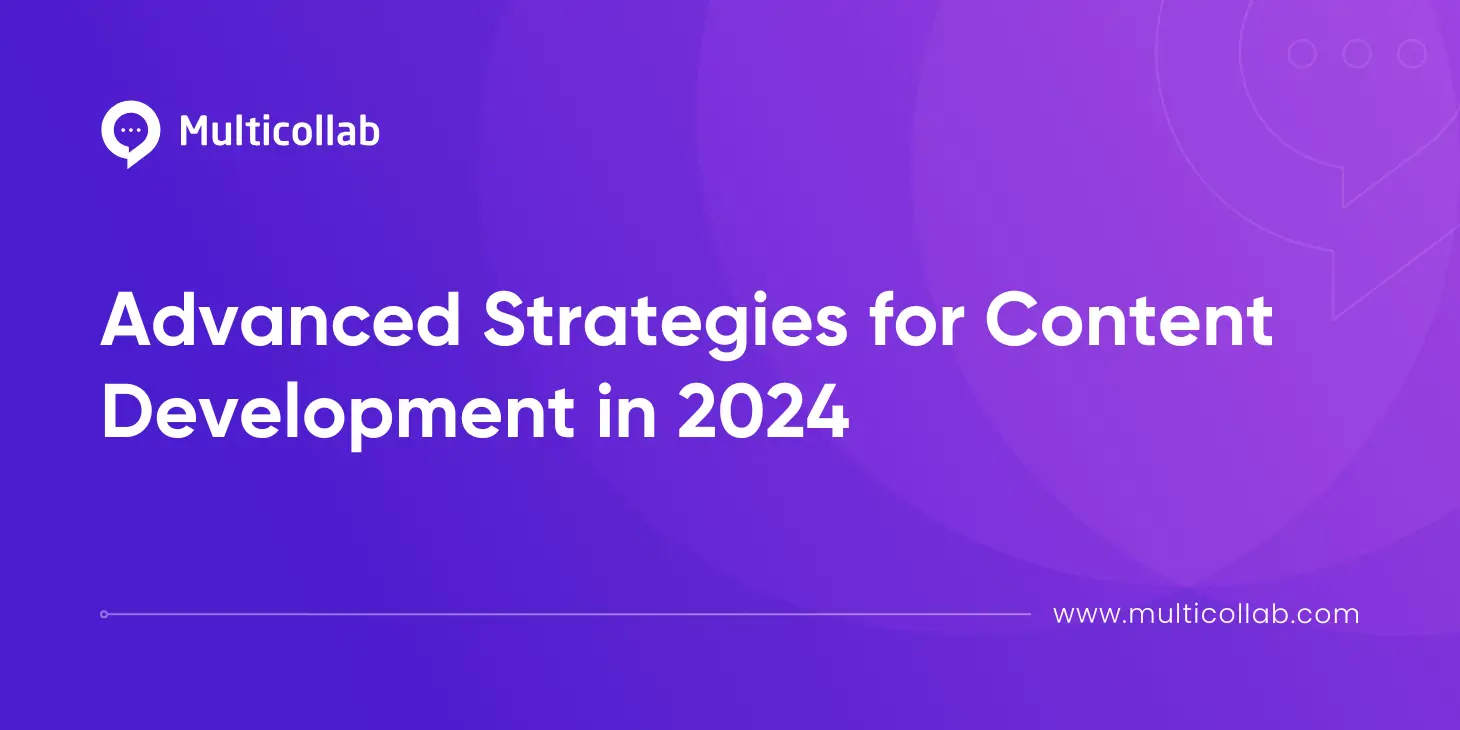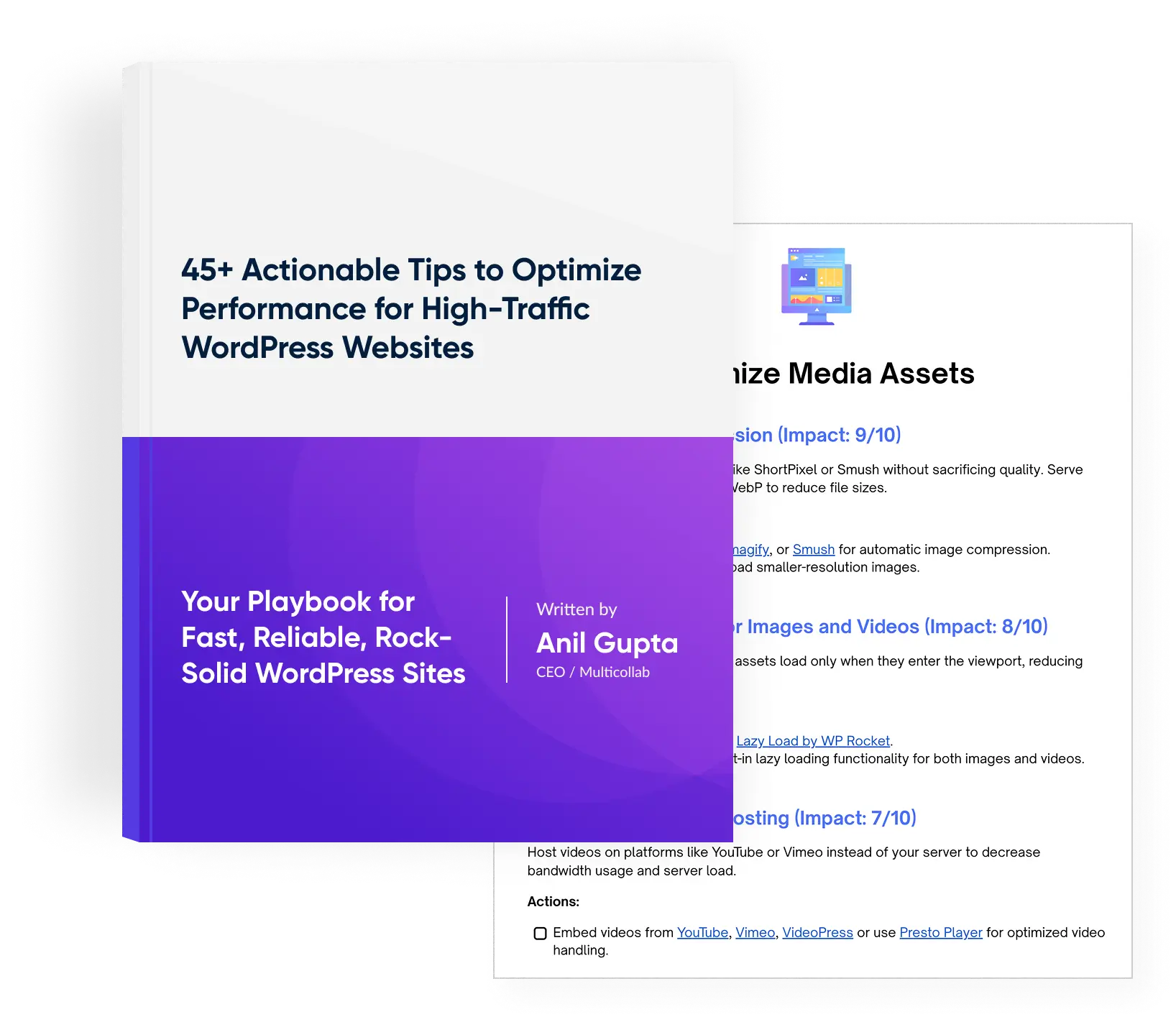Table of Contents
Content development has changed dramatically in recent years, thanks in part to the rise of AI and advanced analytics. It is no longer a straightforward process; marketers now face exciting challenges when it comes to developing content for their brands and clients. With real-time personalized content in high demand, they must navigate the complexities of AI-driven distribution across multiple channels and optimize their content for voice search. Sounds challenging, right?
The solution is to implement cutting-edge strategies that can help you stay ahead in 2024. You need to learn how AI can supercharge your content creation, utilize predictive analytics to gauge content performance, and leverage semantic SEO for voice search.
If you’re part of a WordPress content team, embracing the right tools like Multicollab can significantly streamline your processes. With features such as real-time collaboration and in-content commenting, integrating this plugin into your WordPress workflow becomes effortless. Let’s dive into this guide, where you’ll discover actionable insights designed to help you level up your content development process.
Content development process in 2024: Step-by-step guide
A clear, actionable content development process is all about strategically creating and managing valuable, relevant content to achieve specific business goals. In 2024, it’s not just about churning out content – it’s about working with a thoughtful, dynamic strategy that delivers value while helping your business grow. Think of your content development as an evolving ecosystem. Every part of the process feeds into the next, helping your strategy grow and adapt over time.
Here’s a simple step-by-step guide to get you started:
Step 1: Set clear content goals. First things first: your content should tie directly into your business objectives. Whether you’re aiming for more website traffic, brand recognition, or increased sales, your content goals need to align with your bigger business picture. Make sure these goals are measurable so you can track your success.
Step 2: Research your audience. To create content that really hits the mark, you need to understand your audience’s needs and preferences. You should dive deep into what makes them move – what problems are they trying to solve? Use surveys, social media insights, and customer feedback to get a clear picture of who you’re talking to.
Step 3: Develop a content strategy. Based on your goals and audience research, it’s time to map out a strategy. This means deciding on topics, formats (blog posts, videos, social media), and the best channels for reaching your audience. Your content types should align with what your audience prefers and what helps you achieve your goals.
Step 4: Create an editorial calendar. A good editorial calendar is your roadmap. It keeps your content creation and publication organized so nothing falls through the cracks. Plan out when and where your content will be published for maximum impact.
Step 5: Establish a creation and review process. Content creation isn’t a random occurrence; it follows a structured process. From brainstorming ideas to drafting, editing, and final approval, establish a well-defined process for content ideation, creation, and reviews to keep your entire team aligned and working toward a common goal.
Step 6: Optimize for SEO and user experience. Make sure your content is not just well-written but also well-organized and easy to find. Optimizing for search engines (SEO) means doing things like keyword research and ensuring your content is formatted correctly. And don’t forget to make it user-friendly, especially for mobile readers.
Step 7: Distribute content across channels. Once your content is live, share it where it matters most. Whether it’s through social media, newsletters, or even paid ads, get it in front of the people who will benefit from it the most.
Step 8: Analyze and refine. Last but definitely not least, keep an eye on how your content is performing. Check your metrics; what’s working, what isn’t? Use that data to fine-tune your strategy and make sure your content stays fresh and relevant.
By continually refining your approach based on real data and feedback, you’ll stay ahead of the game and keep your audience engaged.
Advanced content development strategies
Content marketing is evolving fast, and to stay ahead, you need to adopt cutting-edge strategies. These techniques should boost your content’s effectiveness as well as help you keep up with changing audience preferences and meet the demands of modern search engines. In this section, we’ll take a look at four advanced approaches that are reshaping content development and will help create content that resonates with today’s savvy, digital-first audiences.
Harnessing AI and machine learning for personalized content creation at scale
AI tools can take the heavy lifting out of content creation by generating initial drafts or providing content ideas based on extensive data analysis. This means writers can spend less time starting from scratch and more time refining and enhancing their work. For instance, platforms like OpenAI’s ChatGPT can draft articles or suggest headlines tailored to specific topics or audiences, giving creators a solid foundation to build upon.
AI-powered content generation
Imagine a system that analyzes user behavior and preferences to deliver customized content experiences. That’s exactly what personalization engines do. By leveraging data on how users interact with content, these systems can provide tailored recommendations that resonate with individual audience members, enhancing engagement and satisfaction. This leads to a more meaningful connection between the content and its consumers.
Personalization engines
Think about how nice it is when content feels like it was made just for you. Personalization engines make that happen! By analyzing user behavior, these systems deliver tailored content experiences that truly resonate with individual preferences. The result? A deeper connection between your audience and the content they engage with, making it more relevant and enjoyable for them.
Automated content optimization
Want to boost your content’s performance? Automated optimization tools can review your content and suggest tweaks to improve SEO and readability. They’ll check things like keyword usage and sentence flow, helping you create pieces that rank well and keep readers hooked.
Predictive analytics
AI-driven predictive tools forecast how your content will perform, giving you insights into which topics or formats will resonate most with your audience. This means better engagement and conversions, as you’re targeting what matters most to your audience.
Smart content curation
Curating content can be a time-consuming task, but AI simplifies it. With smart content curation, you can effortlessly select relevant pieces that align with different audience segments. This means you can share content that speaks directly to specific groups, keeping them engaged and informed without the hassle.
Even though AI offers all these powerful capabilities, it’s essential to keep a balance between automation and human creativity. While you enjoy the speed and efficiency of these tools, don’t forget to add the human touch to add authenticity, emotion, and creativity to the content. It’s the perfect complement to what AI brings to the table.
However, striking this balance isn’t without its challenges. Implementing AI in your content strategy can present hurdles such as:
Data privacy concerns: Collecting and analyzing personal data raises privacy issues.
Ongoing algorithm training: AI tools require constant refinement to stay accurate and effective.
Data quality: Ensuring data used for personalization is accurate and up-to-date is crucial.
System integration: AI must work seamlessly with existing content management systems.
Human oversight: Monitoring AI outputs is vital to ensure ethical practices and content authenticity.
Cost: High-quality AI tools often come with significant investment.
Technological changes: Rapid AI advancements mean teams must stay adaptable.
This is where Multicollab steps in to bridge the gap. While AI can help speed up content creation, human collaboration is essential to make sure that content hits the right notes.
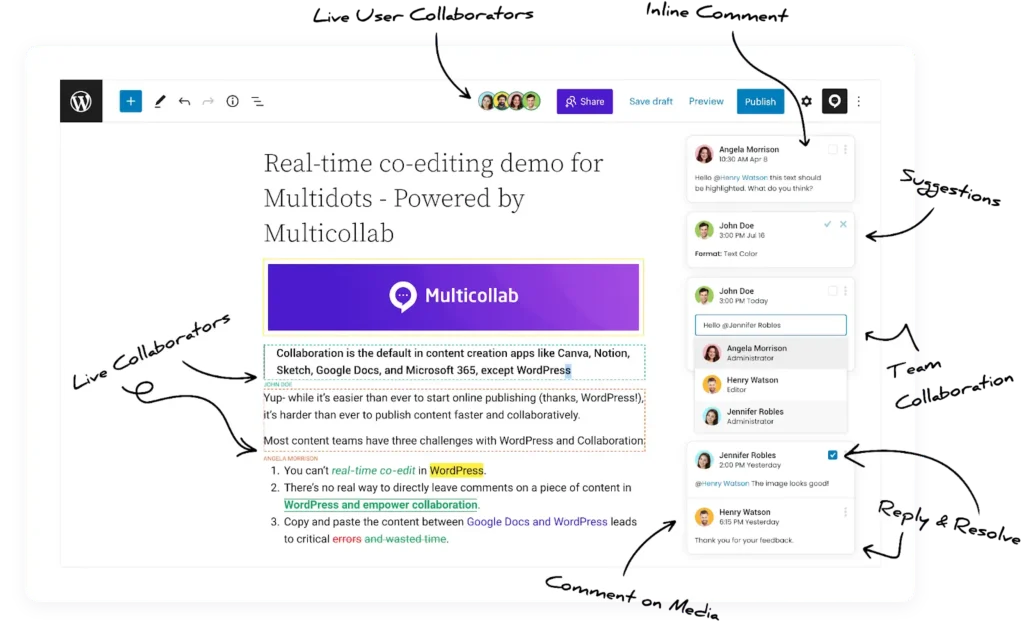
With Multicollab’s real-time editing and feedback features in WordPress, teams can quickly refine AI-generated content to ensure it aligns with your brand’s voice, editorial standards, and creative vision. It’s about merging the best of AI with the creativity and insight that only humans can bring.
Optimizing for voice search and featured snippets: Next-level SEO tactics
As search behaviors shift, optimizing for voice search and featured snippets has become essential for securing prime visibility in search results.
Voice search optimization
With more people using voice assistants like Siri, Alexa, and Google Assistant, content that sounds natural and conversational is critical. Here’s how you can adapt:
- Voice searches are typically more conversational than typed queries. People ask questions like, “What’s the best coffee shop near me?” rather than typing “best coffee shop location.” Structuring your content to answer these types of natural questions can give you an edge.
- Focus on long-tail keywords that mimic how people speak. These are often longer, more specific phrases that align closely with voice queries.
- Create content that directly addresses common questions people might ask. Think “how,” “why,” “what,” and “when” queries. Google often pulls these answers for voice responses, especially if they’re clear and concise.
- Many voice searches are location-based, like “Where’s the closest hardware store?” Including location-specific keywords in your content can help you rank for these queries.
Featured snippet optimization
Featured snippets, or “Position Zero” results, are highly coveted because they appear above regular search results. To land your content in this prime spot, you need to structure it strategically:
- Break down your content with easy-to-read headings and bullet points. Google prefers content that’s structured for quick scanning and easy consumption.
- Snippets usually take answers from content that provides clear responses to specific questions. Try to give these direct answers in the first few sentences of your writing.
- Tables and lists help organize complex information, making it easier for Google to recognize and display as a featured snippet. Whether you’re explaining steps, comparing features, or showing statistics, consider these formats.
- Optimize your H2 and H3 tags with targeted keywords. Search engines look to these subheadings to understand the context of your content, making them a prime place for keyword optimization.
Implementing these tactics requires a solid understanding of your audience’s search habits and the types of questions they’re asking. Tools like Answer the Public can help you identify relevant questions and phrases to target, giving you insight into what your audience is looking for.
Tips for optimizing content for voice search and featured snippets
Analyze existing snippets: Begin by examining the snippets currently ranking for your target keywords. Identify what they’re doing well and how you can create more comprehensive, useful content to outperform them. Explore featured snippets in your industry to see what types of content are highlighted and the questions they answer. This research will help you uncover opportunities for your own content.
Use schema markup: Adding schema markup to your site helps search engines better understand your content’s context, increasing your chances of appearing in featured snippets.
Keep content fresh: Keeping your content fresh and relevant is key. Regular updates not only help maintain your rankings but also ensure that your information reflects the latest trends and insights, increasing its value to readers.
Incorporating these voice search and featured snippet strategies into your SEO approach can significantly enhance your visibility. But while optimizing for these advanced features is important, don’t lose sight of the bigger picture – your content should always aim to provide value to the user, regardless of how they find it.
Creating data-driven content strategies
Data-driven content strategies are key to making sure your efforts hit the mark. By tapping into analytics and user insights throughout the entire content journey, from brainstorming ideas to sharing your final product, you can craft content that genuinely connects with your audience and achieves your business goals. Here’s how you can create a data-driven content strategy that really works for you.
Ideation
Start with data. Use tools like Google Trends, social listening platforms, and audience behavior insights to identify trending topics with high potential. This helps ensure you’re creating content that your audience actually wants to consume, not just what you think they want.
Content planning
Look back at the data from your past content efforts. What worked? What didn’t? By analyzing performance metrics, you can fine-tune your content types, formats, and even your publishing schedule. This means every piece you produce is more likely to succeed, as it’s built on a foundation of what’s proven to work.
Creation
Once you have a plan, it’s time to dig into user preferences. By studying engagement patterns and reading habits, you can tailor the length, depth, and structure of your content to match what your audience craves. Whether they prefer quick, snappy reads or long-form, in-depth pieces, data can guide your creative choices.
Optimization
Experiment with A/B testing for headlines, content length, images, and videos. Testing different elements allows you to see what gets the best response. Sometimes, a small tweak can lead to a big boost in engagement.
Distribution
Data doesn’t stop after creation. Leverage your audience data to distribute content at the right time through the right channels. Analyzing when and where your audience is most active helps you get the most reach and impact.
Implementing a data-driven strategy
- To succeed, set clear, measurable objectives for each piece of content.
- Establish a robust tracking system using tools like Google Analytics, social media insights, and other content analytics platforms.
- Regularly review performance data, and most importantly, balance those insights with your creative intuition and brand voice.
- The best content strategies combine data-driven decisions with creative storytelling, making your content both insightful and original.
Measuring content ROI using advanced analytics techniques
Measuring the return on investment (ROI) for your content is essential for justifying your investments and fine-tuning your strategies. With advanced analytics techniques, you can gain deeper insights into how your content performs and its impact on your business.
First up is multi-touch attribution. This technique allows you to analyze how different pieces of content contribute to conversions at various stages of the customer journey. You’ll see how each blog post, video, or social media update plays a role in guiding potential customers toward a decision.
Predictive analytics takes things a step further by using historical data to forecast future content performance and ROI. By looking at past trends, you can make informed predictions about what types of content will resonate with your audience. This helps you prioritize your efforts and allocate your budget effectively.
Content decay analysis tracks how the value of your content changes over time. Knowing when and why certain pieces lose relevance allows you to update and repurpose them proactively, keeping your content library fresh and engaging for your audience.
Audience segmentation is all about measuring how content performs among different user groups. By analyzing engagement and conversion rates across various segments, you can refine your targeting strategies and ensure your content resonates with each specific audience.
Finally, cross-channel impact assesses how your content performs on different platforms and touchpoints. This comprehensive view helps you identify where your content shines and where it might need improvement, guiding your distribution strategy and maximizing your reach.
To effectively implement these techniques, follow these steps:
Set up comprehensive tracking: Start by putting tracking mechanisms in place across all your content touchpoints. Use tools like Google Analytics, UTM parameters, and custom links to capture how users interact with your content across social media, email, and your website. This way, you’ll gather detailed insights into user engagement.
Integrate analytics with CRM and sales data: It’s important to link your content analytics with your CRM systems and sales data. This connection gives you a full picture of how your content is driving customer behavior – from that first spark of interest to the final sale.
Utilize advanced analytics tools: Invest in analytics tools that can handle complex data. Platforms like HubSpot, Tableau, or the advanced features of Google Analytics can help you sift through large data sets and find actionable insights. Look for tools that offer multi-touch attribution and predictive modeling to keep your strategy agile.
Develop custom KPIs: Instead of just tracking general metrics like page views, create key performance indicators (KPIs) that reflect what matters most to your business. Review your performance data on a weekly or monthly basis. This routine helps you spot trends and informs your content strategy moving forward.
Instead of just counting page views, dive deeper into the lifetime value of your content and see how it really impacts customer acquisition and retention over time. For example, using cohort analysis helps us understand how engaged users respond to your content compared to others, showcasing its true value. You might also set up a content scoring system to evaluate things like how much engagement your content generates, how effectively it drives conversions, and its overall impact on your brand.
Focus on metrics that relate directly to your business goals. By creating custom dashboards that gather data from different sources, you’ll have a clearer view of how your content is performing. This way, you’ll have the insights needed to make meaningful improvements and truly elevate your content strategy.
Streamlining content workflows: Boosting efficiency and collaboration with Multicollab
Managing content workflows in WordPress can sometimes feel frustrating. From juggling multiple contributors to dealing with version control headaches, the challenges are real. Whether you’re a small team or part of a larger organization, inefficient collaboration can slow down the entire process, making it tough to stay on schedule. This is where Multicollab can help content teams enhance their WordPress workflows.
Imagine a world where you can bring the same seamless collaboration you love in Google Docs right into your WordPress environment. That’s exactly what Multicollab does.
With its real-time editing capabilities, you and your team can work on documents simultaneously, which is a game-changer for maintaining a smooth workflow. Plus, it’s fully compatible with Gutenberg, so you can continue using your favorite block editor without any hiccups.
One of the standout features of Multicollab is its inline commenting and suggestion mode. Instead of sifting through endless email threads or chat messages for feedback, team members can leave comments directly on the document. This streamlined approach makes it easy to gather input, implement changes, and keep everyone on the same page.
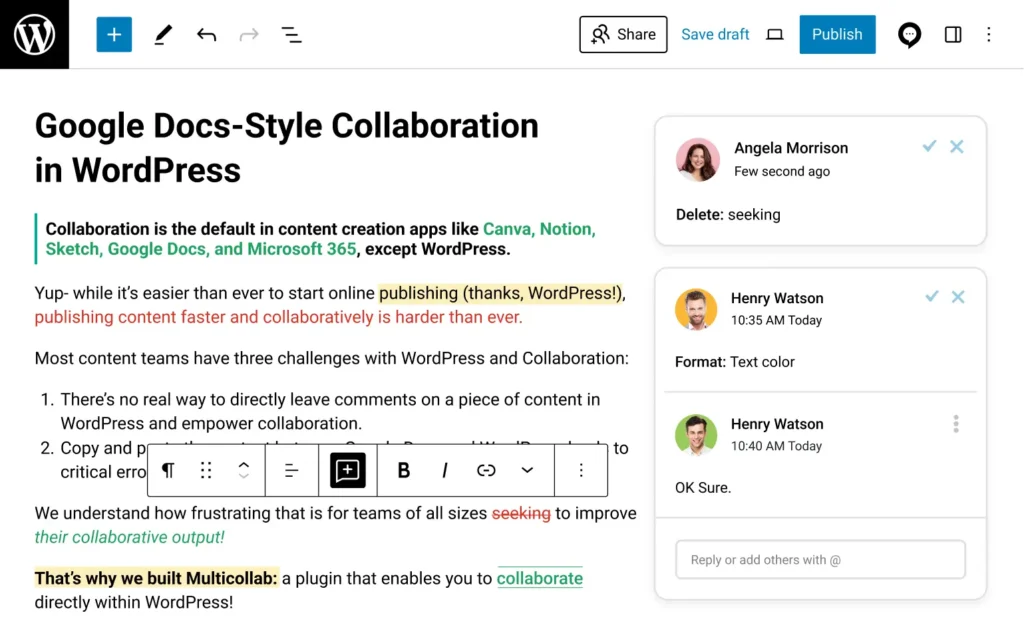
Think about all the time your team would be saving. By reducing the draft-to-publish cycle, you can launch content faster and respond to market changes more effectively. With productivity features like @mentions for quick notifications, task assignments, and the ability to attach documents to comments, you’ll wonder how you ever managed without it.
And let’s not overlook the importance of staying in sync. Multicollab integrates Slack and email notifications, so your team can coordinate effortlessly, regardless of where they are.
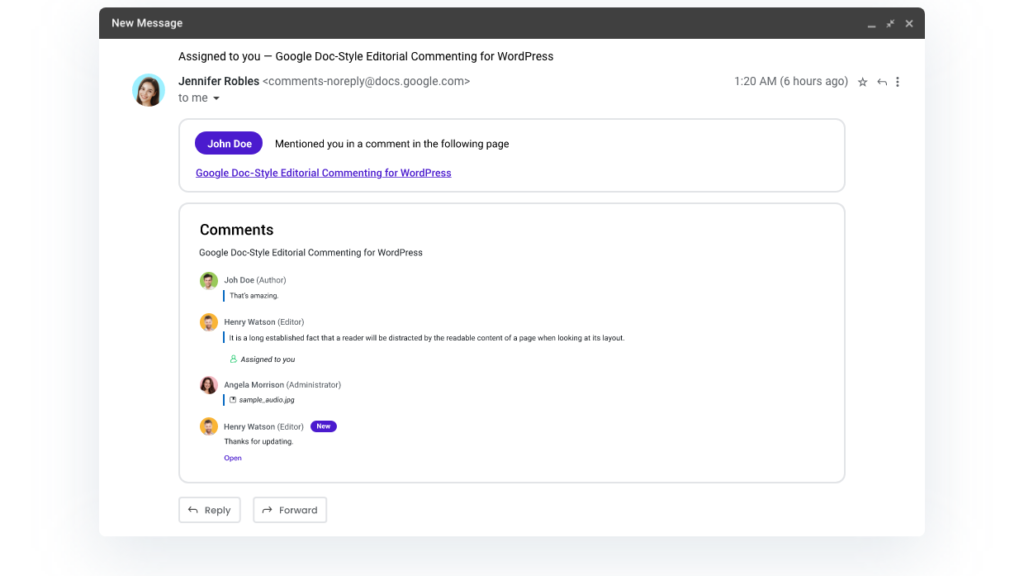
Keeping your content within WordPress means you’re leveraging a platform designed with security in mind. With Multicollab, you also get access to the Advanced Dashboard, which provides transparent insights into your editorial workflows and tracks content progress through intuitive reporting features.
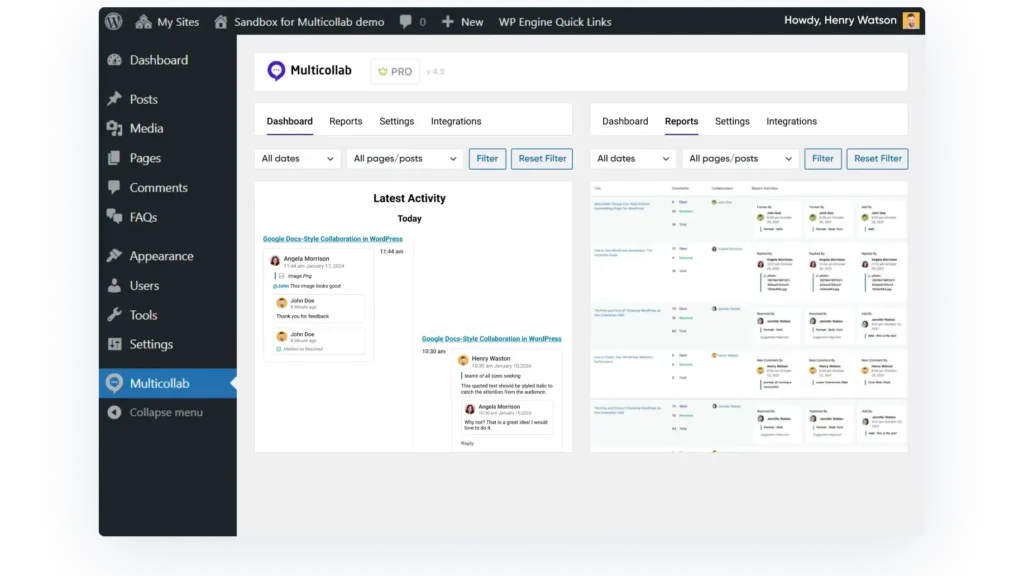
Multicollab’s custom permissions ensure everyone has the access they need without compromising security. It’s the bridge between traditional WordPress publishing and modern collaborative work environments.
If you’re looking to enhance your content team’s efficiency and stay competitive, Multicollab is the tool that can help you make that leap.
Future-proof your content strategy: Action steps for 2024 and beyond
Staying ahead in the content game requires a proactive approach. Embracing new technologies is crucial for modern content teams; they not only enhance content quality but also help you connect with your audience in more meaningful ways.
Data-driven decision-making will remain crucial, so don’t give in to guesswork. Efficient, collaborative workflows will stay equally important, allowing your team to adapt swiftly to the evolving digital audience preferences.
This is where Multicollab shines as an essential solution for enhancing collaboration within WordPress, significantly reducing draft-to-publish time and streamlining your editorial processes. So, why wait? Consider adopting collaborative tools like Multicollab and future-proof your content strategy today.


